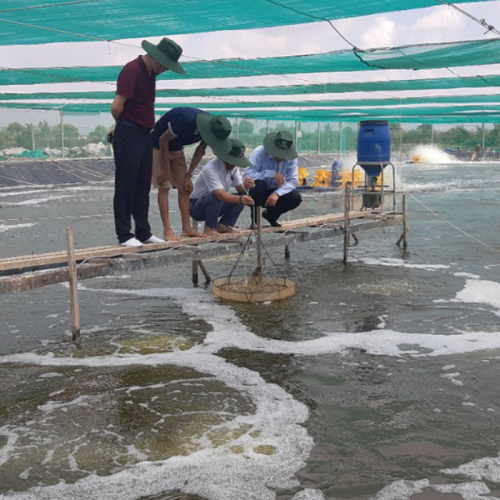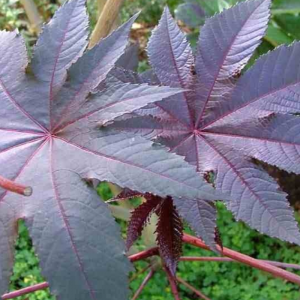
High Technology and High Density in Semi-biofloc Shrimp Farming
| Wed, 18 May 2022 - 10:36
In order to improve efficiency in whiteleg shrimp farming, reduce risks of diseases and environmental pollution, Binh Dinh Agricultural Extension Center (DARD) researched and built demonstration models of farming technology transfer. Namely white leg shrimp Semi-biofloc.
Semi-biofloc technology is understood as cleaning and stabilizing the water environment by microalgae. Biofloc blocks are heterotrophic bacteria, algae, and humus to help purify water and provide a source of nutrient-rich food for species; while inhibiting the growth of pathogenic microorganisms, minimizing the risk of diseases caused by water pollution, thereby limiting the death of shrimp due to disease.
In order to apply Semi-biofloc technology, shrimp farmers must fully prepare technical facilities to meet the requirements, including: The pond system is covered with canvas, the roof, the water treatment system, and the fan system. Drying and applying a 2-stage shrimp farming process: After 25-30 days of rearing, shrimp seed will reach a size of 600-800 shrimp/kg, then move to ponds. Stocking density is 180 - 200 fish/m2 . During the rearing process, farmers apply molasses incubation to create food adhesion; Floc culture is provided for the aquarium.
Read more: Shrimp Farming by Semi-Biofloc Technology
From research on Semi-biofloc technology and process, in 2021, the Provincial Agricultural Extension Center cooperates with localities to demonstrate a number of models of intensive and semi-intensive commercial vannamei shrimp farming. using semi-biofloc technology. The results of the implementation of the models bring about economic efficiency, environmental improvement, and social security.
Mr. Tran Quang Nhut, Deputy Director of Binh Dinh Agricultural Extension Center, project leader "Research and application to perfect the technical process of intensive commercial vannamei shrimp farming (semi-intensive farming applying Semi-biofloc technology) towards sustainable development in Binh Dinh” shared, Semi-biofloc technology brings great efficiency to shrimp farmers.
In terms of productivity, the application of semi-biofloc technology helps to double the yield compared to conventional farming (the yield increases due to the stocking density can reach from 180 - 200 shrimp/m2, while the density of conventional farming is increased. Raising from 100 - 150 shrimp/m2, extensive farming is even lower, only from 50 - 60 shrimp/m2).
Shrimp farming applying semi-biofloc technology helps to reduce input costs by 10-15% compared to conventional farming (due to the reduction in the cost of antibiotics to prevent disease, the cost of wasted feed); limited use of groundwater compared to conventional farming thanks to the stabilization of the water environment by microalgae.
Read more: Intestinal Bacteriome of Pacific White Shrimp in Biofloc, Clear Water Systems
Semi-biofloc technology is relatively easy to accept and master, especially in the early stages, farmers should grasp it. make sure the pond treatment process; monitor the amount of water, perform well techniques of molasses incubation and floc mass culture.
Based on the evaluation of the achieved results in 2022, Binh Dinh Agricultural Extension Center cooperates with 3 localities including Phu Cat district, Phu My district, Hoai Nhon town to build 3 models of whiteleg shrimp farming to using semi-biofloc technology with a scale of 1,500 m2 .
Currently, the Center together with localities plan to select farming households that meet the requirements; formulating plans; The model is expected to be deployed in March, 2022. The pilot implementation of models aims to bring this technology to a wide range of shrimp farmers; households can visit to learn techniques from demonstration models, step by step helping shrimp farmers apply this technology.
According to Mr. Pham Van Thanh, Deputy Director of the Agricultural Service Center of Phu My district, the Center has now coordinated with My Thanh commune to select and re-evaluate the criteria of households participating in the applied vannamei shrimp farming model. semi-biofloc technology.
Read more: Relationship Between Vannamei Size and Consumption of Bioflocs
My Thanh has about 300 hectares of whiteleg shrimp farming, piloting this model offers an opportunity for shrimp farmers in the commune to apply and change shrimp farming. It is expected that at the beginning of this March, the Center in collaboration with the Agricultural Extension Center of Binh Dinh province will come down to check the model one last time before choosing to deploy it.
Mr. Nguyen Tat Tung, who has applied semi-biofloc technology to shrimp farming in Cat Minh commune (Phu Cat district) liked: This year's shrimp crop, I continue to maintain and apply semi-biofloc technology on a large scale. 19 ha/8 ponds. With this technology, my shrimp farming has come a long way. In my opinion, the key issue in applying this model is to adhere to the technique of keeping and controlling the temperature and water quality in the aquarium.
With the mechanism of nutrient decomposition thanks to beneficial bacteria, it creates a source of nutrients for shrimp and saves money on feed costs. Environmental problems in ponds are well controlled, and economic efficiency is increased. According to Mr. Nhut, in the structure of the agricultural sector in the period of 2021 - 2025, the aquaculture sector focuses on developing shrimp farming applying high technology, biosecurity, minimizing environmental pollution; building intensive whiteleg shrimp farming areas, applying high technology semi-biofloc.
Based on this Project, the Center, as a facilitator in science, technology and technology transfer, actively builds models, organizes meetings, talks and trains shrimp farmers in applying Using semi-biofloc technology to improve efficiency, gradually forming shrimp farming areas to ensure biosecurity.
___
This article first appeared at tepbac.com. The accuracy of information and the effectiveness of cultivation contained therein is not Minapoli's responsibility.






















